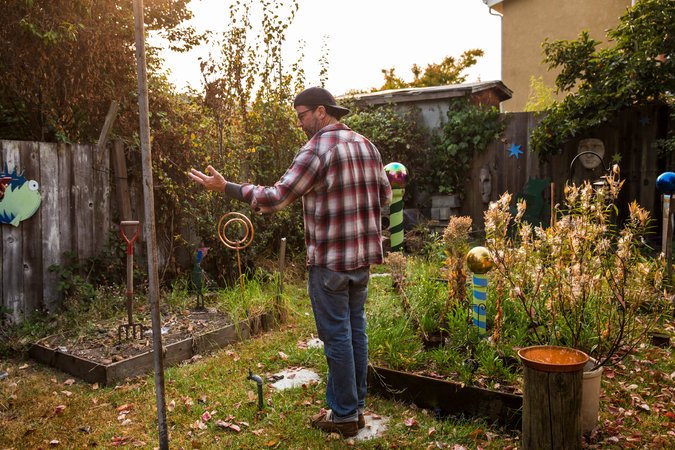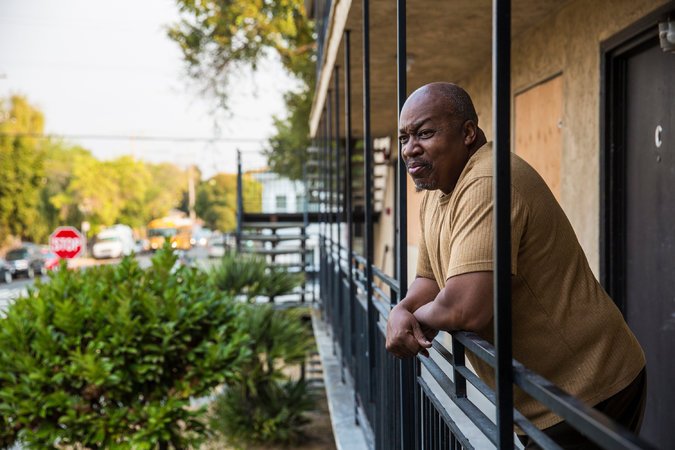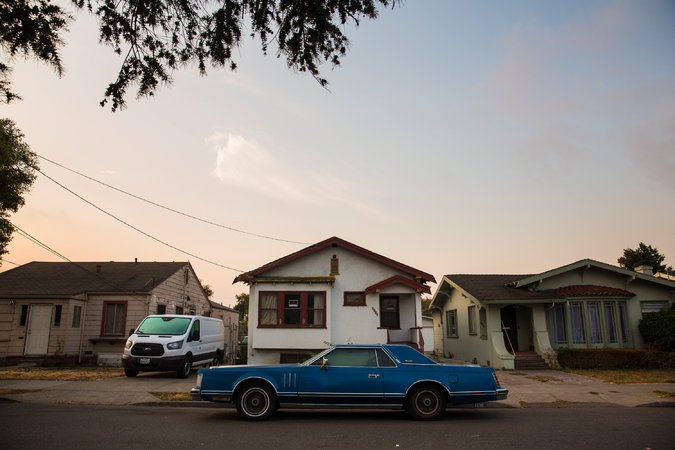Even with a flurry of legislation, economists are skeptical that California can dent home prices anytime soon. Housing takes years to build. And five of the new housing bills included a union-backed measure that requires developers to pay prevailing wages on certain projects, something that critics say will increase the cost of construction.
Advertisement
Continue reading the main story
But the bigger, thornier question is where all these new residences will go, and how hard neighbors will try to prevent them. The Haskell Street fight shows why passing laws is one thing and building is another, but also gives a glimpse of what the denser neighborhoods of the future might look like — and why lots of little buildings are more important than a few skyscrapers.
Kurt’s Tomatoes
The 1300 block of Haskell Street sits in a kind of transition zone between the taller buildings in downtown Berkeley and the low-rise homes scattered through the eastern hills. The neighborhood has a number of single-family homes, and the street is quiet and quasi-suburban, but there are also apartment buildings and backyard cottages that nod to the city’s denser core.
A little under three years ago, a contractor named Christian Szilagy bought the property and presented the city with a proposal to demolish the house and replace it with three skinny and rectangular homes that would extend through the lot. Each would have one parking spot, a garden and about 1,500 square feet of living space.
The neighbors hated it. The public discussion began when Matthew Baran, the project architect, convened a meeting with 20 or so neighbors in the home’s backyard. A mediator joined him and later filed a three-sentence report to the city: “The applicant described the project. Not a single neighbor had anything positive to say about it. No further meetings were scheduled.”
Not in My Backyard
In Berkeley, a proposal to demolish a single-family residence and replace it with three smaller units has met with disapproval from neighborhood residents. How the proposed three-unit project would sit on the 50-by-150-foot Haskell Street lot, compared with the existing house and garage:
EXISTING STRUCTURES
PROPOSED STRUCTURES
50 FT.
50 FT.
Building 1
Garage
Building 2
150 FT.
150 FT.
Residence
Building 3
Drive
EXISTING STRUCTURES
150 FT.
Drive
Garage
Residence
50 FT.
PROPOSED STRUCTURES
150 FT.
50 FT.
Building 2
Building 1
Building 3
By The New York Times | Source: Baran Studio Architecture
On paper, at least, there was nothing wrong with the proposal. The city’s zoning code designates the area as “R2-A,” or a mixed-density area with apartments as well as houses.
Berkeley’s planning staff recommended approval. But as neighbors wrote letters, called the city and showed up at meetings holding signs that said “Protect Our Community” and “Reject 1310 Haskell Permit!,” the project quickly became politicized.
One focal point was Kurt Caudle’s garden. Mr. Caudle is a brewpub manager who lives in a small house on the back side of Ms. Trew’s property (that lot has two homes, or one fewer than was proposed next door). Just outside his back door sits an oasis from the city: a quiet garden where he has a small Buddha statue and grows tomatoes, squash and greens in raised beds that he built.
In letters and at city meetings, Mr. Caudle complained that the homes would obstruct sunlight and imperil the garden “on which I and my neighbors depend for food.” Sophie Hahn, a member of the city’s Zoning Adjustments Board who now sits on the City Council, was sympathetic.
Advertisement
Continue reading the main story
“When you completely shadow all of the open space,” Ms. Hahn said during a hearing, “you really impact the ability for anybody to possibly grow food in this community.”

The debate was easy to caricature, a textbook example of what housing advocates are talking about when they decry the not-in-my-backyard, or Nimby, attitude. Reality is more nuanced. As cities become magnets for high-paying jobs and corporate headquarters, there has been a backlash of anti-development sentiment and a push for protections like rent control.
Home prices in the ZIP code surrounding the 1300 block of Haskell Street have just about doubled over the past five years, to an average of about $900,000, according to Zillow. Those numbers are terrifying to people like L.C. Stephens, 67, who is retired from the state corrections department.
Mr. Stephens pays $1,600 to live in a modest apartment complex that was built in 1963 and sits just a few lots down from the project site. His building was recently purchased by investors and is being painted and renovated. The rehabilitated units go for $2,400 and up.
“People are getting priced out,” he said. “It’s not about ‘We need more housing.’ Yeah, we can use it, but it needs to be affordable.”

The proposed homes are not that. They are estimated to sell for around $1 million. But this is an illustration of the economist’s argument that more housing will lower prices. The cost of a rehabilitated single-family home in the area — which is what many of the neighbors preferred to see on the lot — runs to $1.4 million or more.
Even so, economics is not politics. The argument that quiet, low-slung neighborhoods have to change to keep everyone from being priced out is never going to be a political winner. When the Haskell Street proposal came up for a vote, Jesse Arreguin, who was then a city councilman but is now the mayor of Berkeley, gave a “no” vote that sounded like a campaign speech.
“This issue is bigger than Haskell Street,” Mr. Arreguin said. “This project sets a precedent for what I believe is out-of-scale development that will compromise the quality of life and character of our neighborhoods throughout the city of Berkeley.”
Advertisement
Continue reading the main story
The city’s denial won applause from the crowd. It also drew a lawsuit.
Making It Easier to Sue
Not-in-my-backyard activism has been a fixture of California for long enough that the state already has a law about it. In 1982, Mr. Brown, during his first run as governor, signed the Housing Accountability Act, colloquially known as the “anti-Nimby law.”
The law bars cities from stopping developments that meet local zoning codes. In other words, it’s illegal for cities to ignore their own housing laws. The act is rarely invoked, however, because developers don’t want to sue cities for fear it will anger city councils and make it harder for them to gain approval for other developments.
Lately, the law has become a tool for activists. Two years ago, Sonja Trauss, who leads a group called the Bay Area Renters’ Federation and is running for a seat on San Francisco’s Board of Supervisors, sued Lafayette, a nearby suburb, for violating the Housing Accountability Act, and settled out of court.
Shortly after Berkeley denied the Haskell Street permit, Ms. Trauss sued the city — and won.

Berkeley agreed to give the project a new hearing and consider the Housing Accountability Act when reviewing future development. Neighbors, still incensed, continued to put pressure on the city to deny it. And the city did, this time refusing a demolition permit.
Ms. Trauss sued again, and in July a Superior Court judge for Alameda County ordered the city to issue the permit.
“Organizing alone doesn’t get us out of the crisis,” said Ryan J. Patterson, Ms. Trauss’s lawyer and a partner at Zacks, Freedman Patterson in San Francisco. “You have to have a fist people fear.”
This almost certainly marks the beginning of a trend. Right about the time Ms. Trauss sued Berkeley, Mr. Hanlon started raising money for California Yimby. He found traction in the local technology industry, whose growth is partly responsible for the Bay Area’s housing crunch but whose employees are similarly discouraged by the astronomical rents.
Nat Friedman, a serial entrepreneur who became a vice president at Microsoft after selling his company to the software giant last year, has helped California Yimby raise close to $1 million for its efforts to lobby the state on housing issues.
Advertisement
Continue reading the main story
“The smaller the unit of government, the harder it is to solve this problem,” Mr. Friedman said.
Mr. Hanlon’s first project was to push for a law that would make it easier to sue cities under the Housing Accountability Act. The result was S.B. 167, a bill written by Nancy Skinner, Berkeley’s state senator and a former member of the City Council. In addition to raising the legal burden of proof for cities to deny new housing projects, the bill makes the suits more expensive to defend by requiring cities that lose to pay the other side’s lawyers’ fees.
“What’s frustrating for anybody trying to build housing is that they try to play by the rules and they still get told ‘no,’” Ms. Skinner said.

Ms. Skinner’s law takes effect next year, so the long-term impact is unclear. But just a few weeks before it was signed, the Zoning Adjustments Board had another contentious housing project.
Neighbors had familiar complaints: The homes were too tall, had long shadows, and more residents would make it harder to find parking. The board’s chairman responded that he understood the concerns but couldn’t risk another lawsuit.
California isn’t going to solve its housing problem in the courts. But the basic idea — big-footing local government so that cities have a harder time blocking development — is central to the solutions that the state is pursuing.
This is a state of great ambition. It wants to lead the country on actions to reduce carbon emissions, and has enacted legislation mandating a $15 minimum wage by 2022. But housing is undermining all of it.
Even with a growing economy and its efforts to raise wages, California has the highest poverty rate in the nation, with one in five residents living in poverty, once housing costs are taken into account. And plans to reduce carbon emissions are being undermined by high home prices that are pushing people farther and farther from work.
In a brief speech before signing the recent package of housing bills, Mr. Brown talked about how yesterday’s best intentions become today’s problems. California cities have some of the nation’s strictest building regulations, and measures to do things like encourage energy efficiency and enhance neighborhood aesthetics eventually become regulatory overreach.
“City and state people did all this good stuff,” Mr. Brown said to a crowd of legislators. “But, as I always say, too many goods create a bad.”
Continue reading the main story
Article source: https://www.nytimes.com/2017/12/01/business/economy/single-family-home.html?partner=rss&emc=rss
Speak Your Mind
You must be logged in to post a comment.